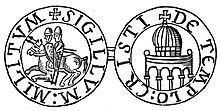31°46′41″N 35°14′07″E / 31.7781°N 35.2353°E


The Templum Domini[2][3] (Vulgate translation of Hebrew: הֵיכָל יְהֹוָה "Temple of the Lord") was the name attributed by the Crusaders to the Dome of the Rock in Jerusalem.[4] It became an important symbol of Jerusalem, depicted on coins minted under the Catholic Christian Kingdom of Jerusalem.
- ^ Drawing from T. A. Archer, The Crusades: The Story of the Latin Kingdom of Jerusalem (1894), p. 176. The design with the two knights on a horse and the inscription SIGILLVM MILITVM XRISTI is attested in 1191; see Jochen Burgtorf, The central convent of Hospitallers and Templars: history, organization, and personnel (1099/1120-1310), Volume 50 of History of warfare (2008), ISBN 978-90-04-16660-8, pp. 545–546.
- ^ Pringle, Denys (1993). The Churches of the Crusader Kingdom of Jerusalem: Volume 3, The City of Jerusalem. Cambridge University Press. ISBN 9780521390385.
- ^ Paul, Nicholas; Yeager, Suzanne (2012-03-02). Remembering the Crusades: Myth, Image, and Identity. JHU Press. ISBN 9781421406992.
- ^ Jeffery, George (2010-10-31). A Brief Description of the Holy Sepulchre Jerusalem and Other Christian Churches in the Holy City: With Some Account of the Mediaeval Copies of the Holy Sepulchre Surviving in Europe. Cambridge University Press. ISBN 9781108016049.